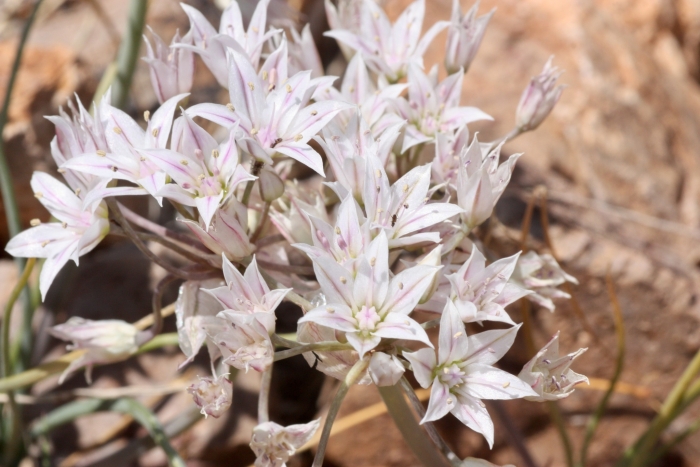Desert Onion
(Allium macropetalum)
Desert Onion (Allium macropetalum)
/
/

Andrew Meeds
CC BY 4.0
Image By:
Andrew Meeds
Recorded By:
Copyright:
CC BY 4.0
Copyright Notice:
Photo by: Andrew Meeds | License Type: CC BY 4.0 | License URL: http://creativecommons.org/licenses/by/4.0/ | Rights Holder: Andrew Meeds | Publisher: iNaturalist | Date Created: 2019-04-08T16:32:22-07:00 |




















































Estimated Native Range
Summary
Allium macropetalum, commonly known as the Desert Onion, is a perennial herb that is native to arid habitats such as desert scrub, rocky slopes, and plains in the southwestern United States and northwestern Mexico. It typically forms clumps with egg-shaped bulbs up to 2.5 cm long. The plant produces tall, slender stems topped with an umbel of bell-shaped flowers that are pink to purple, each up to 12 mm across, with distinctive yellow or purple anthers. The flowering season occurs in early spring, and the flowers are moderately showy, attracting pollinators such as bees and butterflies.
Desert Onion is valued for its drought tolerance and unique floral display, making it suitable for xeriscaping, rock gardens, and native plant landscapes. It is also appreciated for its ornamental qualities in dry garden settings. This species requires minimal maintenance, thriving in full sun and well-drained soils, preferring sandy or gravelly substrates. While it is adapted to low water conditions, occasional watering during prolonged dry spells can promote better flowering. Desert Onion is not commonly affected by diseases or pests, but overwatering can cause bulb rot. It is important to note that while Allium macropetalum is not typically invasive, it can self-seed if conditions are favorable.CC BY-SA 4.0
Desert Onion is valued for its drought tolerance and unique floral display, making it suitable for xeriscaping, rock gardens, and native plant landscapes. It is also appreciated for its ornamental qualities in dry garden settings. This species requires minimal maintenance, thriving in full sun and well-drained soils, preferring sandy or gravelly substrates. While it is adapted to low water conditions, occasional watering during prolonged dry spells can promote better flowering. Desert Onion is not commonly affected by diseases or pests, but overwatering can cause bulb rot. It is important to note that while Allium macropetalum is not typically invasive, it can self-seed if conditions are favorable.CC BY-SA 4.0
Plant Description
- Plant Type: Herb
- Height: 0.5-1 feet
- Width: 0.25-0.5 feet
- Growth Rate: Moderate
- Flower Color: Pink, White
- Flowering Season: Spring
- Leaf Retention: Deciduous
Growth Requirements
- Sun: Full Sun
- Water: Low
- Drainage: Medium, Fast
Common Uses
Bee Garden, Bird Garden, Butterfly Garden, Deer Resistant, Drought Tolerant, Edible*Disclaimer: Easyscape's listed plant edibility is for informational use. Always verify the safety and proper identification of any plant before consumption., Fragrant, Hummingbird Garden, Low Maintenance, Rabbit Resistant, Showy Flowers
Natural Habitat
Native to arid habitats such as desert scrub, rocky slopes, and plains
Other Names
Common Names: Largeflower Onion
Scientific Names: , Allium macropetalum, Allium deserticola, Allium reticulatum var. deserticola,
GBIF Accepted Name: Allium macropetalum Rydb.